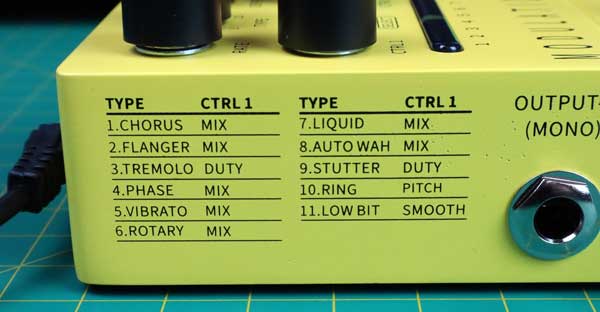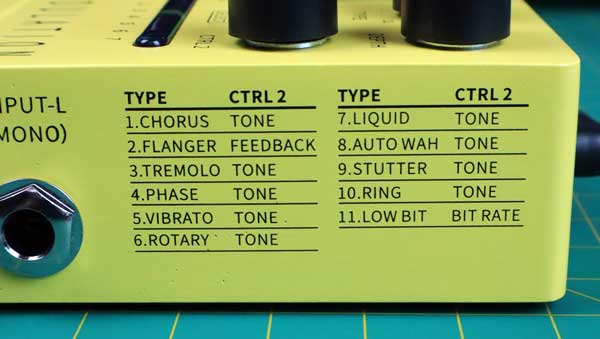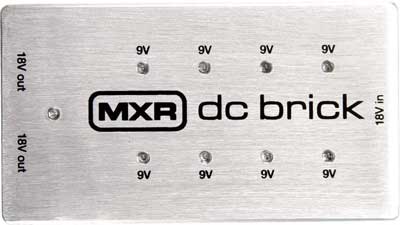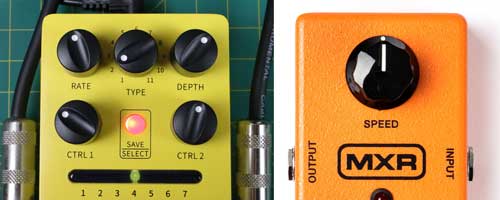The FLAMMA FS05 Multi Modulation is a low-cost pedal that packs in 11 different types of modulation effects. If you’re interested in experimenting with modulation effects but aren’t sure which effects suit your playing style, you might be interested in this pedal.
In this review, I’ll go through the effects and features of the FS05 Multi Modulation to give you a clear idea whether it suits you or not.
There are a lot of different modulation effects such as phaser, flanger, chorus, tremolo, and vibrato.
If you want to learn about all types of modulation effects, how they compare, how to use them, and how to combine them with other effects, check out my Guitar Effects Course.
If you buy this pedal or any other effects pedal, the course will help you get the most out of it and dial in a better guitar tone.
FLAMMA FS05 Multi Modulation Features
Here are the main features of the FS05 Multi Modulation pedal:
- 11 modulation effects
- 7 preset storage positions
- Stereo input/outputs
- Rate, depth, and two control knobs to tweak each effect
- External power only (9V 300mA)
- Buffered bypass
Check out the price and full details of the FS05 Multi Modulation pedal here (link to Amazon for details).

Here are the 11 modulation effects:
- Chorus
- Flanger
- Tremolo
- Phase
- Vibrato
- Rotary
- Liquid
- Auto Wah
- Stutter
- Ring
- Low Bit
If you’re familiar with modulation effects, you’ll probably recognize most or all of these effects. Some are very common (eg: chorus, phaser, tremolo) while others aren’t as common (eg: ring modulator, stutter).
There are two custom control knobs that change function depending on which modulation effect is active.
The left side of the pedal lists the effects and what the ‘CTRL 1’ knob controls:

You can see that most of the effects set this knob to mix, which is a handy parameter when it comes to modulation.
The right side of the pedal lists what the ‘CTRL 2’ knob controls:

Most of the effects use this knob to control tone, with the flanger and low bit effects changing this feature. This makes it pretty easy to remember what the two knobs control, but it’s handy to have the info on the sides of the pedal.
Having this info printed on the side of the pedal was the one feature missing when I reviewed the FLAMMA FS02 Reverb pedal.
FS02 Ease of Use
All of the FLAMMA pedals I have tried out have been simple to use while still packing in a nice range of features.
I’ll go through the main features so you can get an idea of what it’s like to use the pedal.
Selecting Modulation Effects
The middle ‘Type’ knob toggles between 11 numbered positions to select from the list of modulation effects. You simply turn it to match the numbered effects printed on the side of the pedal.
This is pretty standard on pedals that include multiple effects. Some pedals print the name of each effect on the face of the pedal, but those pedals also tend to have fewer control knobs, so they have more space to print info.
If you learn to identify modulation effects by ear, you won’t need to glance at the side of the pedal to know what type of effect has been selected. Otherwise, things can get a bit confusing once you start saving presets.
Saving and Selecting Presets
What I like about the FLAMMA pedals I’ve tried is that most of them allow you to save 7 presets.
The seven-segment strip in the middle of the pedal is where you can toggle between your presets.

Each position uses a different color, which makes it easier to figure out which preset you’re using at a glance.
You press the Save/Select button to scroll through the seven positions.
Once you dial in a tone you’re happy with, you hold down the button for a second until the LED flashes rapidly a few times to confirm the save.
What I like about this system is that you can save any effects you want to each of the seven presets. So if you really like using phasers, you can save up to seven different phaser presets. You’re not limited in what you want in each position.
This is a great system, but it does have a downside. Once you save a preset, there’s no way to find out what your settings were or even what type of effect you saved. So if you wanted to slightly tweak one of your presets, there’s no way to figure out what the initial knob positions were to start tweaking.
If you do tweak a preset, the LED blinks to let you know you have unsaved changes.
Powering the Pedal
All FLAMMA pedals that I’ve seen require an external 9V 300mA power supply. The FS05 doesn’t offer battery power and it doesn’t come with a power supply.
Many guitar pedal power supplies only supply 100mA, so make sure you have one that can supply at least 300mA if you want to buy this pedal. If you plug this pedal into a power supply that only provides up to 100mA, you may experience issues.
The below photo shows an example of what to look for on any power supply:

If you plan on adding one or more FLAMMA pedals to your rig, a power supply such as the MXR M237 Power Brick would be a good option to consider.

The MXR DC Power Brick has eight 9V outputs that can supply a total of 1200mA across the eight outputs. As long as you don’t have many other power-hungry pedals, you can easily use something like this to power the FS05 with the rest of your pedalboard.
Find out more about powering guitar pedals and your different options here.
FS05 Sound Quality
When I saw the low price of the FS05 and the number of effects it packs in, I had low expectations. There are single effect pedals that cost far more than the FS05, so how can it really stand up against those pedals?
When testing out the pedal, at no point did I feel as if the effects sounded low quality or cheap. They all sound exactly as you would expect them to sound.
Here are my quick thoughts on the 11 built-in effects in the FS05:
Chorus
The chorus can go from a subtle shimmer-like effect to the full-saturated chorus you hear in cheesy 80s tracks.
I directly compared this against the TC Electronic Afterglow Chorus, which is their budget chorus pedal. The FS05 was the clear winner – by far. You have far more control over the chorus in the FS05 and if you want, you can saturate your tone far more than what is possible with the Afterglow Chorus.
I almost always add chorus to my clean tone to add some color and I was surprised by how much I liked the sound of this chorus.
The CTRL 1 knob controls the mix, so you can dial in the perfect amount of chorus to your dry tone. The CTRL 2 knob changes to tone, which allows you to control how warm or bright the chorus sounds.
Overall, the chorus sounds fantastic. At no point did I feel anything was lacking in how it sounded or in the range of control the knobs provided.
I had a look through the pedals in my Best Chorus Pedals Guide after playing with the chorus in the FS05. While some of the pedals offer more control over the effect that the FS05, I would be perfectly happy recommending this pedal over most of the chorus pedals in that guide.
Flanger
When the rate knob is turned down low, you get the typical jet-engine swooshing sound that makes flanger hated by many guitarists. I did like the way it colored the tone, but I personally don’t really like the jet-engine or siren sound it produces.
For me, the flanger in the FS05 really shines when you crank the rate up. You end up with a pulsing and wobbly effect that reminds me of an auto-wah, vibrato, or tremolo.
The tone produced is crystal clear and even with the mix all the way up, the sound quality is excellent.
Tremolo
As I mentioned in my Ultimate Guide to Tremolo, tremolo is an effect that can completely change the vibe or feel of a song. It’s instantly recognizable in songs and can have a powerful impact on your guitar tone.
The tremolo in the FS05 covers all the basics you would want. You can create a subtle tremolo that slightly modulates the amplitude (learn how tremolo works and all these other effects in my Guitar Effects Course), or go all the way to full on/off style tremolo sounds.
The CTRL 1 knob controls the duty cycle, which controls the amount of time the signal is reduced vs the original tone. I found this knob did a great job at shaping the feel of the tremolo to suit different playing styles.
You can change between a smooth sweeping tremolo to a jarring tremolo that cuts in and out.
If you’re serious about tremolo, you may prefer one of the pedals in my Best Tremolo Pedals Guide that offers more control. But if you just need a simple tremolo, the FS05 does a great job.
Phase
When you consider that the most popular phaser pedal only gives you one knob to control (the MXR Phase 90), the FS05 already has a big advantage.
You’re able to control so many aspects of the phaser effect in ways that the most popular phaser pedals can’t come close.
Compare the FS05’s range of controls to the control on the MXR Phase 90:

While the Phase 90 sounds great, the only control you have to dial in the perfect phaser tone is the speed knob. So if you ever want more or less depth, or you want to change the mix with the Phase 90, you’re out of luck.
With the FS05, you can set the rate you want, then dial in the depth and mix (CTRL 1) knobs to get the perfect phaser level. Then you can even shape the phaser tone using the CTRL 2 knob while keeping your dry signal untouched.
That’s a huge difference in control – yet the Phase 90 costs twice the price of the FS05. While I’m not saying the Phase 90 is bad, it should be clear how much more you can get with a pedal like this one.
What I like about this pedal is that you can create a warm phaser that blends in with your bright guitar tone, or you can create a bright and clear phaser to blend with your guitar signal. It does such a great job at allowing you to tweak the perfect settings – something that is sorely lacking in many popular phaser pedals.
The only point I found that the phaser was lacking was when the depth and mix knobs were cranked up. I didn’t feel they pushed the effect far enough. But it was definitely still more range than other phaser pedals I’ve tried out.
Overall, the Phaser on the FS05 does a better job than many of the dedicated phaser pedals covered in my Best Phaser Pedals Guide. Some of the pedals do offer more control and more depth, but the FS05 will be perfectly fine for many guitarists who want to occasionally use phaser in their tones.
Vibrato
The vibrato on the FS05 starts with a subtle chorus-like shine to your tone, then as you turn the rate knob up, it drifts into a de-tune effect, then into full-on 50s sci-fi sound effects.
If you’ve ever cranked a chorus pedal up and wanted to go further, the vibrato in the FS05 is a good place to start.
I personally don’t use vibrato pedals often because the de-tune sound often sounds wrong in music. But there were a few settings where I could find myself writing songs just around the effect (modulation effects are often a good source of inspiration for songwriting).
Just like the chorus and flanger sounds on this pedal, the FS05 gives you plenty of range to dial in the effect as you want.
Rotary
The rotary effect on the FS05 sounds really nice. It has a nice warm feel to it and far more range with the depth and mix knobs that you would ever want. You can fully saturate your tone in a way that the phaser didn’t quite reach.
If you haven’t used a rotary effect before, it’s an interesting mix of a phaser, chorus, and tremolo mashed together. You can get some great tones with this effect when you’re able to tweak the parameters – which is what the FS05 does really well.
Liquid
Liquid is the first effect on the FS05 that feels odd. There are a lot of weird-sounding modulation effects and so far all of the effects on the FS05 have been typical. Liquid is weird.
At a slow rate, it creates a strange stepping sound that jumps around in a weird way. As you turn the rate up, it gradually changes to a pulsing or swooshing sound that fits the ‘Liquid’ name.
You can get some interesting sci-fi sounds out of this by cranking the depth and mix knobs, but when you dial them back a bit, the effect actually sounds good. There’s a small sweet spot where I felt the liquidy sound became very useable.
Auto Wah
The auto wah in this pedal isn’t quite like typical auto wah pedals. Auto wah is a filter effect that changes based on how hard you hit the strings (covered in detail in my effects course).
In the FS05, the ‘Auto Wah’ sweeps back and forth through a range at a speed you set. It doesn’t react to your playing like an actual auto wah.
So while it’s not an actual auto wah, you can hear the wah-like quality it adds to your tone.
Stutter
Stutter is basically a tremolo effect with a square waveform. So instead of being able to get a smooth swelling or pulsation as you get in a tremolo effect, you get a jarring tremolo that cuts in and out depending on how you set it.
It works in the same way as the tremolo effect with the CTRL 1 knob controlling the duty cycle. I personally prefer the sound of the tremolo on this pedal, but there may be times when you would like the stutter sound instead.
Ring
I’ve never understood why ring modulators exist. They’re basically unusable, yet they always show up in multi-effects pedals.
Having said that, there are some songs that make decent use of a ring modulator, but those songs are rare.
If you’ve heard a ring modulator before, you know what to expect with how it sounds on the FS05.
Low Bit
The Low Bit effect gives you something in between a fuzz distortion and a ring modulator. If you want your guitar to have an old-school game console tone, this effect gets you close.
You can control the bit rate (CTRL 2), the shape of the sound (CTRL 1) to dial in the right sort of jagged sound. The Depth knob acts as a mix knob so you can blend your guitar signal with the low bit sound. When the depth knob is turned all the way up, you get zero dry signal and things start to get weird.
Overall Impression of the FLAMMA FS05 Multi Modulation Pedal
The FS05 gives you a very nice range of modulation effects for a lower price than a typical chorus or phaser pedal.
The effects sound fantastic and many guitarists would struggle to justify spending more money on a phaser or chorus pedal when the FS05 gives you both of those effects and much more for a low price.
The ability to save up to seven presets, the stereo input/output, and the amount of control you have over each effect makes the FS05 an impressive pedal.
I’m really impressed with the FS05. Even when compared to pedals double the price, the FS05 does a fantastic job.
Check out the price and full details of the FS05 Multi Modulation pedal here (link to Amazon for details).
FS05 Modulation Pros
- Nice variety of modulation effects
- Good quality effects in stereo or mono
- The ability to save seven presets is handy
- Excellent value for money
FS05 Modulation Cons
- Requires a 300mA power supply (not included)
- No battery power option
- No way to easily find a preset’s saved settings after changing the knobs
Who is the FLAMMA FS05 Multi Modulation For?
If you want to play around with modulation effects or you play songs that occasionally use them, you might want to consider the FS05. Being able to easily access a nice range of modulation effects for such a low price is a great way to try out new sounds.
Being able to save seven presets in any way you like allows you to dial in different modulation effects to suit different songs. If you don’t like the idea of buying a phaser or chorus pedal just to use in one or two songs, I suggest using a multi modulation pedal like this one.
Even if you already have some modulation pedals such as chorus or phaser, having a pedal like the FS05 is handy whenever a song pops up using some random modulation effect you don’t already have.
Who isn’t the FLAMMA FS05 Multi Modulation For?
You only get the real benefit of the FS05 when you make use of the range of modulation effects built in. If you’ll only be using one type of effect in your rig, it may not make sense to buy a pedal with so many modulation effects built-in.
If you’re a live guitarist and you regularly need to switch between different modulation effects during a set, you may prefer a pedal where you can access different presets by foot. A pedal such as the Line 6 HX Stomp may suit you better in that situation.
How to Get the Most Out of the FLAMMA FS05 Multi Modulation
The best way to get the most out of the FS05 is to learn about each effect built into the pedal.
If you know the difference between a chorus, flanger, phaser, and vibrato, it makes it easier to dial in the perfect settings for each type of effect.
If you want to learn about all types of modulation effects, how they compare, how to use them, and how to combine them with other effects, check out my Guitar Effects Course.
If you buy this pedal or any other effects pedal, the course will help you get the most out of it and dial in a better guitar tone.
Check out the Guitar Effects Course here.
Hear the FS05 Multi Modulation in Action
I’m currently working on a video to showcase the range of modulation effects the FS05 can produce.
Subscribe to my YouTube channel here for updates and new videos.
Alternatives to the FLAMMA FS05 Multi Modulation Pedal
If you’re not sure whether the FS05 is right for you or not, it might help to think about what type of modulation effects are important to you.
You may find that you only want one or two modulation effects, or you may find that you have a use for most of the effects in the FS05.
Here are some guides to help you work out which effects you might be interested in and alternative pedals for each effect:
I don’t have guides on all of the effects built into the FS05, but the above guides will give you a good idea of alternative pedals to consider.

























